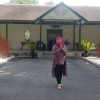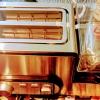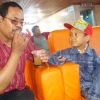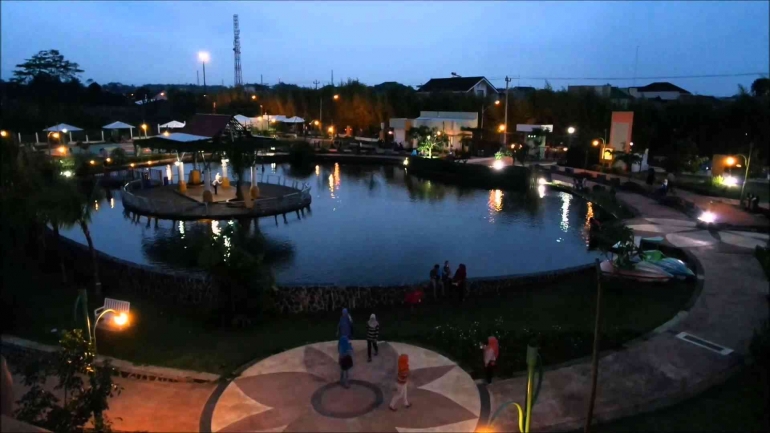IMAGE OF MAS KEMAMBANG TOURISM PARK IN TOURISM MARKETING PERSPECTIVE IN BANYUMAS DISTRICT
Eko Harinatalistini, SE
Dinas Pariwisata Kab. Banyumas
ekoharinatalistini@gmail.com
ABSTRACT
Taman Mas Kemambang has potential that needs to be developed. Therefore, a development strategy is needed so that the image of Taman Mas Kemambang can continue to be built and can develop and increase the interest of tourists to visit again. The research method used is a qualitative research method. Data collection is done by interview, observation, and documentation. The sampling technique used purposive sampling. The validity of the data used is the data triangulation method. The data analysis technique used is interactive analysis technique (data reduction, data presentation, and conclusion drawing). The instruments used are the opinions of tourist visitors, Micro, Small and Medium Enterprises, hotels, restaurants around tourism, and public opinion.
Seeing the market potential in Mas Kemambang Floating Park, it has a great opportunity to be developed into a millennial tourist location that suits market needs. From the results of the research, it is known that the tourism marketing strategy carried out by the Banyumas Dinporabudpar is to innovate the development of the diversity of tourist facilities including renovating existing facilities and adding a number of new rides. From the results of the study, it is known that the impact of developing tourist vehicles on the image or brand image in the eyes of the community can continue to be well developed, continue to grow and increase tourist interest to visit again.
Keywords: Marketing Strategy, Tourism Object Development, Taman Mas Kemambang
Gambar diambil dari : https://www.mgriyahotel.com/attraction/taman-balai-kemambang/
INTRODUCTION
Marketing is the most important activity for organizations that offer or sell goods or services. Through these activities the organization makes contact with external parties to sell its products. Kotler and Keller (2016) define marketing as a social and managerial process, by which individuals and groups obtain what they need and want through creating, offering and exchanging products of value with other people or groups.
Marketing can cover a wide range of sectors, including tourism. Zebua (2016) stated, tourism is one of the priority sectors of the Indonesian government's development, because it provides a large multiplier effect in the Indonesian economy. Various other sub-sectors, such as accommodation, transportation, to Micro, small and medium enterprises (MSMEs) also get opportunities from the tourism industry.
The COVID-19 pandemic has had a huge impact on various sectors of the economy. The tourism industry is one of the sectors most affected by the pandemic. Since February 2020 the number of foreign tourists entering Indonesia has decreased very drastically, and the peak occurred in April 2020 with only 158,000 tourists. In total, throughout 2020 the number of foreign tourists entering Indonesia was only around 4.052 million people. only about 25% of the number of tourists who entered Indonesia in 2019. As a result, according to BPS 2020 data, around 409 thousand workers in the tourism sector lost their jobs due to the Covid-19 pandemic (Kemenparekraf/Baparekraf, 2021).
The Covid-19 pandemic is currently starting to subside. Various economic sectors, including the tourism sector, have begun to revive. Sharma et al (2021), examined the rise of the post-pandemic tourism industry. The results of his research outline four main factors for building the resilience of the tourism industry in times of crisis, namely: government response, technological innovation, a sense of belonging to the local community, and consumer and employee trust. A new economic order characterized by the rise of sustainable tourism, community welfare, climate action, and local community involvement is expected to be developed after the Covid-19 pandemic.
To manage the crisis situation in the tourism industry due to the Covid-19 Pandemic, so far the central, provincial, and city/district governments have tried to work together. Matching funds during emergencies, matching programs during recovery, and matching promotions with joint events, have been tried to accelerate the handling of the crisis phase in the tourism sector. The strategy in the recovery phase towards the normalization phase to rebuilding tourism brand awareness has become strategic and synergistic steps taken by the government (Saraswati & Afifi, 2022).
The Covid-19 pandemic has not hindered efforts to develop the tourism sector. This is found in the efforts of the Banyumas Regency Government to develop various tourist objects in Banyumas Regency, especially the Mas Kemambang Floating Park. The tourist attraction, which was originally named Taman Balai Kemambang, is located in Karangkobar Village, which is an urban area. The location is quite strategic so it is very easy for people to visit it.
The development of the Mas Kemambang Floating Park is expected to build a positive image of the Mas Kemambang Floating Park, for example as an attractive, clean and tidy tourist attraction, having unique rides/facilities, cheap but still of high quality, and so on. This is very important to support the marketing of Taman Apung Mas Kemambang in the long term. The more positive the image that is built, the higher the chance of repeat visits by tourists.
This study aims to assess the impact of the development of the Mas Kemambang Floating Park. The impact studied is focused on the image of the Mas Kemambang Floating Park and the potential for repeat visits by tourists.
LITERATURE REVIEW
The tourism sector has a strategic role in national development to support the improvement of people's welfare. Law Number 10 of 2009 concerning Tourism states that the implementation of tourism is aimed at increasing national income, expanding and equalizing business opportunities and employment opportunities, encouraging regional development, introducing and utilizing tourist attractions and destinations in Indonesia, and fostering a sense of love for the homeland. and strengthen international friendship. Development in the tourism sector plays an important role in increasing people's income and welfare.
Kasali (2017) suggests that marketing can be defined as a series of activities including advertising (advertising), sales (setting), public relations (public relations), sales promotion (sales promotion), direct marketing (direct mail), pricing. , market research (market research) and so on.
The marketing studied in this research is marketing in the field of tourism. The definition of marketing in this field can have its own characteristics that can be different from the marketing concept in general. According to Muljadi (2009), tourism marketing is an effort to identify the needs and desires of tourists, and to offer tourism products that are in accordance with the wishes and needs of tourists with the intention that tourism businesses can provide maximum service to tourists.
Marketing has a number of elements called the marketing mix. The marketing mix or marketing mix is a marketing tool or tool used by companies for marketing activities in order to achieve the expected results (Widokarti & Priansa, 2019). The marketing mix used by tourism industry players to market tourism products is known as the 8P tourism marketing mix. The marketing mix in tourism consists of 8Ps, namely: product, partnership, people, packaging, programming, place, promotion, and price (Morissan, 2010).
According to Kotler and Keller (2016), image is the actual way people perceive a product. In order for the correct image to be embedded in the minds of consumers, marketers must pay attention to brand identity through all available means of communication and brand contact.
The concept of image is generally attached to a brand, so that it develops into a brand image. According to Tjiptono (2015) brand image is a description of consumer associations and beliefs about certain brands. The brand image of a good product will encourage potential buyers to buy the product rather than buying the same product with other brands.
The concept of brand image has attracted significant attention from academics and practitioners as it plays an important role in marketing activities. Brand image is the main driver of brand equity, which refers to consumers' general perceptions and feelings about the brand and has an influence on consumer behavior. For marketers, the main purpose of marketing activities is to influence consumer perceptions and attitudes towards brands, build brand image in consumers' minds, and stimulate consumer buying behavior, so as to increase sales, maximize market share and develop brand equity (Zhang, 2015).
Brand image is not only focused on physical products produced by the company, but also service products, such as tourism. Image in the realm of tourism can be related to various aspects related to tourism objects. According to the results of Chi & Qu's research (Cyasmoro, 2020) states that the instruments used to measure the image variables of tourist destinations are nine indicators, namely the environment, nature tourism, events and entertainment, historical/cultural attractions, infrastructure, accessibility, relaxation, outdoor activities. , as well as price and value.
A number of previous research results have discussed the image in the world of tourism. Chen & Pao (Cyasmoro, 2020) tested the effects of image, personality, relationship and destination loyalty by conducting a survey of 428 foreign tourists visiting Angkor Temple in Cambodia. The results showed that the image of the destination has a direct effect on satisfaction. According to research results. Kim & Petrick (2018) show that Brand Awareness has a positive impact on tourist destinations.
RESEARCH METHODOLOGY
This research was conducted in Mas Kemambang Floating Park, Banyumas Regency. The main target of this research are visitors to the Mas Kemambang Floating Park, while the supporting targets are the managers of the Mas Kemambang Floating Park, officials/staff of the Banyumas Regency Dinporabudpar and business actors in the tourism object. The research method uses qualitative methods. Determination of informants using the "purposive" technique. Data collection techniques used in-depth interviews, observation, and documentation. To ensure the validity of the data used triangulation technique. The data analysis technique used interactive model analysis.
RESULT
Komalasari (2019) stated that the tourism sector is one sector that has the potential to continue to be developed in order to strengthen the regional economy. In this regard, development efforts related to tourism activities need to continue to receive attention from the government. The success of this effort is greatly influenced by various factors, such as regional security, tourism facilities and infrastructure, and even the global situation. Conditions that are not conducive will directly affect the number of tourist visits entering tourist areas, both domestic tourists (archipelagic tourists) and tourists from abroad (foreign tourists).
Banyumas Regency is one of the main tourist destinations in Central Java Province. The Government of Banyumas Regency is very aware of the magnitude of tourism potential and has a strong commitment to develop various existing tourism potentials. This commitment is empirically realized, among others, through the development of the Mas Kemambang Floating Park. The Banyumas Regency Government sees the potential for the Mas Kemambang Floating Park to have a great opportunity to be developed into a millennial tourist location according to market needs (an instagramable location with a variety of culinary delights and water tourism attractions).
The Banyumas Regency Government through the Banyumas Regency Youth, Sports, Culture and Tourism Office (Dinporabudpar), as its leading sector, has made various real efforts to develop the Mas Kemambang Floating Park.
Based on the results of questionnaire research on visitors, it shows that simultaneously tourist facilities, as well as services and security contribute significantly to visitor satisfaction with the image of the Mas Kemambang Floating Park. Thus it can be explained that if the variables of tourist facilities, as well as service and security are improved together, it will be followed by increasing visitor satisfaction and the good image of tourists to Mas Kemambang Floating Park and vice versa if the variables of tourist facilities, as well as service and security decrease simultaneously. At the same time, it will be followed by a decrease in visitor satisfaction and good image of Taman Apung Mas Kemambang.
Partially, tourist facilities, as well as service and security have a significant effect on visitor satisfaction. The good image of visitors to Taman Apung Mas Kemambang will be detailed as follows:
- The influence of tourist facilities partially contributes to visitor satisfaction and the good image of visitors to the Mas Kemambang Floating Park by 80%. From the results of the study, it was revealed that 80% of respondents stated that the tourist facilities implemented by the manager were in the very satisfactory category (strongly agree). Mas Kemambang Floating Park has implemented tourist facilities which include tourist attraction facilities, public facilities, and satisfactory service from officers so that visitors are satisfied with the facilities provided. This is in accordance with the opinion of Lupiyoadi (2001:148) that the tangible or physical evidence of services, equipment facilities used and other physical representations affect the satisfaction of service users.
- The influence of service and security, on the image and satisfaction of visitors partially contributed to 1.25%. From the results of the study, it was revealed that 80.50% of respondents stated that the services and security implemented by the Mas Kemambang Floating Park were in the good category. This is due to the fact that Mas Kemambang Floating Park has implemented assurance which focuses on guarantees regarding the friendliness and courtesy of workers in providing services to visitors, recreational park security which includes the safety of visitors and parking lot security, as well as workers' knowledge of the recreational park situation. This is in accordance with the theory that assurance is one aspect of service quality that affects visitor satisfaction (Lupiyoadi, 2001:148).
Data from interviews with managers indicate that the tourism marketing strategy carried out by the Banyumas Regency Dinporabudpar is to innovate the development of tourism facilities diversity in the Mas Kemambang Floating Park. The development strategy carried out includes renovating existing facilities and adding a number of new rides.
The development of the Mas Kemambang Floating Park by the Banyumas Regency Government was carried out, among others, by renovating existing facilities and adding a number of new rides, such as: a garden with a colorful shop house and a unique hexagonal house, an Instagramable garden with unique benches and flower decorations with a Love model, a pond Big fish, floating house in the shape of a ship and barn house, playground for children, fountain pool, water bike, floating restaurant. There is also an expansion of the parking area, improvement of toilet facilities and trash cans, in order to increase the comfort of tourists. In addition, the management also involves MSMEs in the tourism area, especially culinary business actors. This business actor is focused on local residents in particular and Purwokerto residents in general, so that the impact of the development of the Mas Kemambang Floating Park can also be felt directly by the local community.
The results of the development of the Mas Kemambang Floating Park make this tourist attraction more attractive than before. The community also welcomed it well, which was indicated by the large number of visitors, both on weekdays and even more so on weekends. Visitors who became research informants stated that the current Mas Kemambang Floating Park is much better and more attractive than before. Not only new tourist facilities, even the appearance of the front gate is considered very attractive, thus generating great interest in visiting it. Researchers observed that the gate of the Mas Kemambang Floating Park is like a front cover. An attractive front cover display is easier to increase consumer interest. On the other hand, the front cover that is made carelessly is certainly less attractive and also less marketable, even though the content presented is actually very interesting.
Various new rides also make the Mas Kemambang Floating Park also have a comparative advantage considering the tourist attractions in the vicinity, both in Banyumas Regency and several other adjacent regencies. Such conditions can make the Mas Kemambang Floating Park more marketable than before. This means that the actual condition of the Mas Kemambang Floating Park after development provides a conducive climate for tourism marketing.
The informant's view that the current condition of Mas Kemambang Floating Park is better is a reflection that the development of Mas Kemambang Floating Park has a real impact on improving the image of tourist destinations in Mas Kemambang Floating Park. The positive image that is built in the minds of the informants is certainly very meaningful in supporting tourism marketing for the Mas Kemambang Floating Park because it allows the dissemination of positive information about the Mas Kemambang Floating Park on a wide scale. So, these kinds of people can become free promotional agents, so the opportunity to increase the number of visitors is more open. Some of the informants will certainly share their memorable experiences when visiting Mas Kemambang Floating Park to others, so that they can encourage people who receive positive information to visit Mas Kemambang Floating Park.
A positive image will be more positive if it can be built and maintained in a sustainable manner. This, in the perspective of tourism marketing, has the potential to encourage high public interest in visiting in the long term. The argument is, visitors who have a positive image of Taman Apung Mas Kemambang, not only want to repurchase or visit again at another time, but also have the potential to share their positive impression with others. This can happen in a chain through word by mouth schemes.
The above concept is in line with the results of research by Tasci and Gartner in Artuğer et al. (2013) which explains that the image of the destination affects the behavior of tourists, which include the intention (interest) to revisit, recommend to others, or return to related tourism destinations. In addition, it also strengthens the research of Lobato et al. (2006); Chen and Tsai (2007); and Prayag (2008) in Coban (2012) who confirmed that future behaviors that assess positively the image of a tourism destination include revisiting and recommending related destinations to others. Coban's research (2012) proves that there is a significant effect of destination image on tourist satisfaction. A positive image of a destination causes high satisfaction and a negative image causes dissatisfaction or displeasure. Sun et al. (2013) through his research on Hainan tourism destinations, China also proved that tourists who develop a positive perception (image) of Hainan get better satisfaction with their experience. This proves that the image of the destination has a positive effect on tourist satisfaction when visiting tourism destinations. The study by Dinporabudpar (2022) also confirms, through a good destination image, it will not only influence a potential tourist to make decisions, but also influence the behavior of tourists, whether tourists will return or even suggest others to come to the destinations they have visited.
The behavior of repurchasing, or revisiting in the context of tourism marketing, shows that the positive image of a tourist destination is a reflection of the satisfaction felt by tourists who visit a tourist attraction. The higher the perceived satisfaction, the more positive the image that is built and it is more likely to make repeat purchases on an ongoing basis. This condition is theoretically in accordance with the opinion of Tjiptono (2015), that a buying decision-making process does not only end with the occurrence of a purchase transaction, but is also followed by a stage of post-purchase behavior (especially in broad decision making), in this stage consumers feel a level of satisfaction. or certain dissatisfaction that will affect subsequent buying behavior, if the consumer is satisfied he will show a great opportunity to make repeat purchases. A satisfied consumer tends to tell others.
CONCLUSION
- The development of the Mas Kemambang Floating Park is carried out by renovating existing facilities and adding a number of new rides. This development makes Mas Kemambang Floating Park considered much better than before. All of this has a positive impact on increasing the positive image of the Mas Kemambang Floating Park. Along with the positive image that is built, the interest of tourists to visit again becomes higher.
- Based on the results of the study, the tourism facilities variable has a positive effect on the image and satisfaction of visitors to the Mas Kemambang Floating Park. This means that the more equipped tourist facilities variables will be able to increase the good image and satisfaction of visitors to Taman Apung Mas Kemambang.
- Service and security variables have a positive effect on the image and satisfaction of visitors to Taman Apung Mas Kemambang. This means that if the service and security variables for visitors are improved, the good image and visitor satisfaction of Taman Apung Mas Kemambang will be increased.
REFERENCES
Artuğer, S., et al. (2013). The Effect of Destination Image on Destination Loyalty: Application in Alanya. European Journal of Business and Management, 5 (13) : 124-136.
Chen, Ching Fu and D. Tsa. (2007). “How Destination Image and Evaluative Factors Affect Behavioral Intentions?” Tourism Management, 28 (4): 1115-1122.
Coban, S. 2012. “The Effects of The Image of Destination on Tourist Satisfaction and Loyalty: The Case of Cappadocia”. European Journal of Social Sciences, 29 (2) : 222-232.
Cyasmoro, Verry . (2020). “Analysis of the Effect of Promotion, Brand Awareness, Destination Image on Tourist Visiting Satisfaction at Situ Gintung Park and BSD Ocean Park, South Tangerang City. Journal of Eduturisma, 8th Edition, Volume IV Number 2.
Chi, C. G. Q., & Qu, H. (2008). Examining the Structural Relationships of Destination Image, Tourist Satisfaction and Destination Loyalty: An Integrated Approach. Tourism Management, 29 (4).
Dinporabudpar. (2022). “Feasibility Study of Mas Kemambang Floating Park Business”. Purwokerto: Dinporabudpar Banyumas.
Kasali, Rhenald. (2017). Advertising Management: Concepts and Applications in Indonesia. Jakarta: Gramedia Pustaka Utama.
Kemenparekraf/Baparekraf. (2021). Indonesian Tourism Trends in the Midst of a Pandemic. Kemenparekraf.go.id.
Kim, Choe and Patric. (2018). “The Effect of Celebrity on Brand Awareness, Perceived Quality, Brand Image, Brand Loyalty, and Destination Attachment to a Literary Festival”. Journal of Destination Marketing & Management (2018)
Komalasari, E.D. (2019). “Analysis of Tourism Sector Development in Increasing Regional Original Income (Pad) from the Islamic Economic Perspective (Study at the Bandar Lampung City Tourism Office)". Research result. Lampung: UIN Raden Intan.
Kotler, P., dan K. L. Keller. (2016). Marketing Management. Jakarta: Erlangga.
Lobato, L.H., et.al. (2006), “Tourism Destination Image, Satisfaction and Loyalty: A Study in Ixtapa-Zihuatanejo, Mexico”, Tourism Geographies, 8 (4), pp.343–358.
Morissan, M. A. (2010). Advertising: Integrated Marketing Communications. Jakarta: Prenada Media Group.
Muljadi. (2009). Tourism and Travel, Jakarta: Raja Grafindo Persada.
Saraswati, Hesti Dwi & Subhan Afifi. (2022) “Tourism Marketing Communication Strategy in the Covid-19 Pandemic Period”. Journal of Coverage, Vol. 12, No. 2.
Sharma, G.D., Thomas, A., & Paul, J. (2021). Reviving tourism industry post-COVID-19: A Resilience-Based Framework. Tourism Management Perspectives, 37 (October 2020).
Sun, X., et al. (2013). “Developing destination loyalty: The Case of Hainan Island”. Annals of Tourism Research, 43 : 547-577.
Tjiptono, Fandy. (2015). Service Marketing. Yogyakarta : Andi Offset.
Widokarti, Joko Rizkie & Donni Juni Priansa. (2019). Contemporary Consumer, Marketing & Communications. Jakarta: Faithful Library
Zhang, Yi. (2015). “The Impact of Brand Image on Consumer Behavior: A Literature Review”, Open Journal of Business and Management, 2015, 3, 58-62.
Zebua, M. (2016). Regional Tourism Development Inspiration. Yogyakarta: Deepublis.











